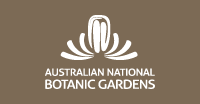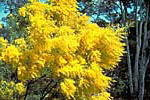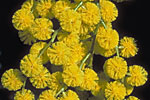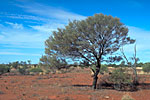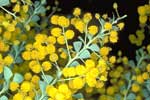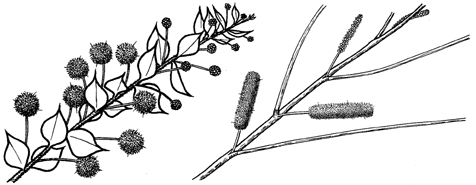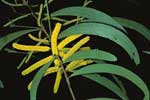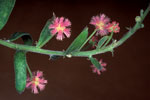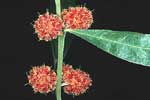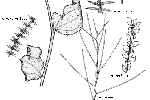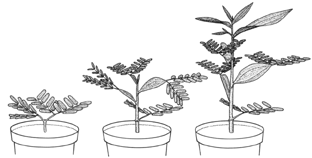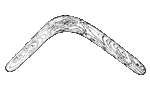(100 species descriptions in a single document with links to the currently available photos from APII ) |
(100 species with links to individual descriptions with a portrait photo of each species ) |
- a controversy in the botanical community 2006 |
|
Introduction
The genus Acacia belongs to the family Mimosaceae. There are some 1350 species of Acacia found throughout the world and close to 1000 of these are to be found in Australia. Commonly known as Wattle, Acacia is the largest genus of vascular plants in Australia. Australia's national floral emblem is Acacia pycnantha, the Golden Wattle. Wattle Day is celebrated on the 1st of September each year. |
Distribution
Within Australia Acacia occupies vast areas of the continent and is to be found in a wide range of differing habitats from coastal to sub-alpine regions and from high rainfall to arid inland areas. They are particularly prevalent in the arid and semi-arid and the dry sub-tropical regions of the country. Acacia is to be found in Australia, Africa, Madagascar, throughout the Asia - Pacific region and in the Americas. |
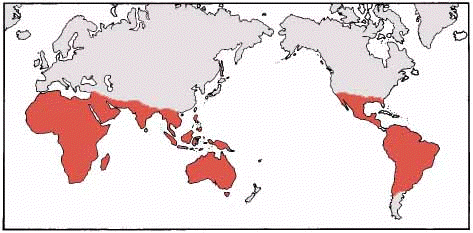 |
Flowers
Individual flowers are arranged in inflorescences that may be either globular heads or cylindrical spikes. Each inflorescence may comprise from as few as 3 individual flowers (e.g. Acacia lunata) to as many as 130 or more (e.g. Acacia anceps). Acacia species flower throughout the year although the bulk of species flower during spring and summer and a lesser number flower during autumn and winter. |
||
|
||
Flowers can vary in colour through cream, pale yellow to gold. One species, Acacia purpureapetala, has purple flowers whilst a form of Acacia leprosa has red flowers. The flowers of many species are delicately perfumed. |
Foliage
Acacia show a range of foliage types. The true leaves are divided into leaflets, but a large group of wattles develop modified flat leaf-like structures called phyllodes (which are simply flattened stems) soon after germination. The foliage colour of Acacia ranges from light or dark green to blue or silver-grey. |
|
 |
A few species lack true leaves or phyllodes altogether and in these plants cladodes (which are simply modified stems) function as the leaves. Cladodes are illustrated at left in this Acacia glaucoptera. |
Acacia as Garden Plants
Acacia make excellent garden plants. They range in habit from prostrate and low-growing species to larger shrubs and shade trees. Most respond to pruning immediately after flowering and, if carried out regularly, pruning can extend the life of the plant. As Acacia species flower throughout the year it is possible, with careful selection, to have Acacia flowering in the garden at all times of the year. Acacia are a good source of pollen making some species popular with bee-keepers. The seeds are also an important source of food for birds. The main pests are stem borers which can be controlled by probing with flexible wire or by injecting a few millilitres of alcohol into the holes. Galls are often more difficult to control, but removing the effected branches can reduce the problem. Acacia Bug (Eucerocoris tumidiceps) can cause damage to the foliage of wattles with phyllodes and is difficult to control. Treatment with a systemic insecticide may be required. |
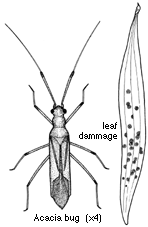 |
Propagation
Propagation from seed is the most common method. Seeds are readily available and can be stored for many years. The very hard seed coat needs to be scarified (worn away) or softened before water can enter and germination can take place. Pouring boiling water over the seeds and leaving them to soak for 24 hours will usually soften them. The infertile seeds will float to the surface and should be discarded. Swollen seeds can be sown, the others can be retreated. Many species of Acacia can be grown from cuttings using firm new seasons growth. Cuttings from species with phyllodes are easier to strike than those with bipinnate leaves. More information on the propagation of Acacia can be found on our 'Growing Native Plants' site. |
Acacia and People
All parts of various Acacia species have been or are used by people for one purpose or another. The seeds from some specific Acacia species provide a valuable food source. Mostly the seeds are ground into a flour and cooked like damper although some are eaten raw or made into a porridge. The gum from some species is also edible. Various extracts from the bark and the leaves or phyllodes have been and continue to be used by Australian Aborigines for a wide variety of medicinal purposes such as relieving toothache or colds or applying to wounds and burns. Green leafy branches of some species may be used to 'smoke' someone who is suffering from a general sickness. The wood of various species has been used to make clubs, spears, boomerangs and shields. Some species, such as Acacia melanoxylon (Blackwood), are used to make fine furniture. Tannin has been extracted from the bark of a number of species for use in tanning including Acacia dealbata (Silver Wattle), A. mearnsii (Black Wattle) and A. pycnantha (Golden Wattle). |
Further Reading
Flora of Australia Volume 11A, Mimosaceae, Acacia part 1. Melbourne: ABRS/CSIRO Publishing (2001). Flora of Australia Volume 11B, Mimosaceae, Acacia part 2. Melbourne: ABRS/CSIRO Publishing (2001). WATTLE: Acacias of Australia (2012) http://www.worldwidewattle.com/infogallery/publications/wattle.php Acacias of South Australia web site http://www.flora.sa.gov.au/id_tool/acacia.html |
![An Australian Government Initiative [logo]](/images/austgovt_brown_90px.gif)





